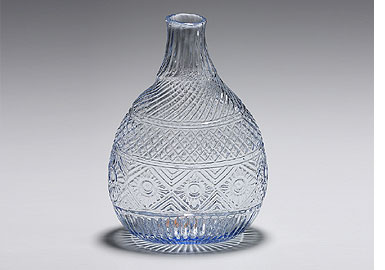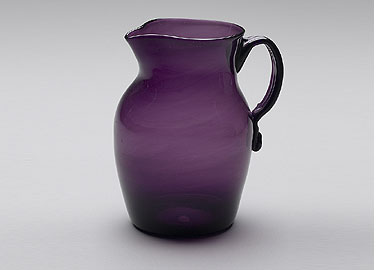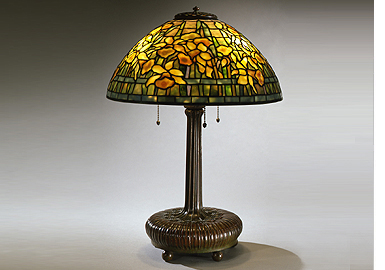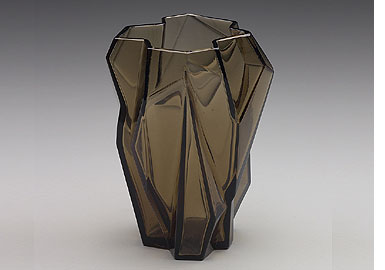DAS reorganizes awards and opens submissions
The DAS has reorganized its Robert C. Smith Award Committee and Charles F. Montgomery Prize and Award Committee, and submissions are now open.
The Robert C. Smith Award recognizes the best article or exhibition catalogue/book essay about the decorative arts published in the previous year. The article or essay must be in English and have been published for the first time. Both debut and seasoned authors are welcome to submit for the award. This award is in memory of Dr. Robert C. Smith, who taught the art and architecture of the United States, Spain, Portugal and South America at the University of Pennsylvania. The award follows in the tradition he established for clearly presented, original and innovative research.
The DAS presents the Charles F. Montgomery Award to the scholar(s) whose first major publication in the field of the American decorative arts is judged the most outstanding such work published in the previous year. The Charles F. Montgomery Prize is given to the most distinguished contribution to the study of American decorative arts published in the English language by a North American scholar in the previous year. These awards are in memory of Charles F. Montgomery, who was a director of the Winterthur Museum, Library and Garden; curator of the Garvan and related collections at the Yale University Art Gallery; and a professor of the history of art at Yale University — an inspirational teacher, creative curator and eminent scholar.
The closing date for submissions for consideration of works published in 2023 is June 3, 2024. Recipients will be announced in November 2024.
For further details about submitting works published in 2023 for the Montgomery Prize and Award, contact Lea Lane, committee chair, at LLane@oldsalem.org.
For Smith Award submission information, contact Ann Glasscock, committee chair, at Aglasscock@taftmuseum.org.
Awards history
• The Charles F. Montgomery Award was established at the 1979 DAS annual meeting and first awarded in 1980 for a publication appearing in 1979. According to the DAS newsletter at the time: “Early in his career, Charles F. Montgomery recognized the importance of studying American artifacts to understand better our national heritage. With this vision, he dedicated his career to building the institutions and programs for research and interpretation of American decorative arts, and he fostered the training of teachers and curators in the field. Thus, it was appropriate to designate this award for an author’s first major contribution to scholarship in American decorative arts.”
• The Charles F. Montgomery Prize came later and was first awarded for works published in 1982.
Montgomery (1910–1978) was an inspirational teacher, creative curator and innovative teacher. A 1932 graduate of Harvard College, he served on the staff of the Winterthur Museum during the 1950s and 1960s, and director from 1954–1961. From 1970–1978, he was curator of the Garvan and Related Collections of American Art at the Yale University Art Gallery and professor of the history of art at Yale University. His publications include American Furniture: The Federal Period (1966), A History of American Pewter (1973), and contributions to American Art, 1750–1800: Towards Independence (1976).
• The Robert C. Smith Award was established in March 1978 and first presented in 1979. Smith was known for his abiding interest in students in the field, unfailing generosity in sharing information and ability to shed light on previously overlooked areas of research. He published scores of articles about furniture and the decorative arts, and had a lengthy teaching relationship with the Winterthur Museum. His books include Samuel Tibau and Portuguese Inlaid Furniture of the Seventeenth Century (1962) and The Art of Portugal, 1500–1800 (1968).
Past DAS awards
2016
The DAS chose Early Seating Upholstery: Reading the Evidence by Leroy Graves (Colonial Williamsburg Foundation, 2015) as the 2016 recipient of its Charles F. Montgomery Prize for the most distinguished contribution to the study of American decorative arts published in the English language by a North American scholar in the previous year. Graves joined the facilities maintenance staff of Colonial Williamsburg (VA) in 1967 and was soon recruited to be an art handler in the Department of Collections, a position he held for nearly 10 years. He joined the Conservation Department at its inception in 1984. His minimally intrusive upholstery techniques have been copied and adapted by colleagues at institutions across the country.
The DAS took the unusual step of presenting its 2016 Robert C. Smith Award for the best article about the decorative arts published in English in 2015 to two recipients, due to the unexpected number of worthy publications: Lisa Minardi for “Sulfur Inlay in Pennsylvania German Furniture: New Discoveries” in American Furniture (2015) and Andrea Pappas for her article “‘Each Wise Nymph that Angles for a Heart’ in the Politics of Courtship in the Boston ‘Fishing Lady’ Pictures” in Winterthur Portfolio (Vol. 49, No. 1/Spring 2015, pp. 1–28). Minardi is an assistant curator at Winterthur and a specialist in Pennsylvania German art and culture; Pappas is an associate professor in the art and art history faculty of Santa Clara University (CA) and was previously a lecturer/adjunct professor at the Otis College of Art and Design and a visiting lecturer at UC Santa Barbara and the University of Southern California (USC).
Full details of the year's awards are in the Fall 2016 issue of the DAS Newsletter, a benefit of contributing to the DAS.
2015
The 2015 Robert C. Smith Award of the DAS for the best article published in 2014 in English on the decorative arts went to Freyja Hartzell for her article “A Renovated Renaissance: Richard Riemerschmid’s Modern Interiors for the Thieme House in Munich,” published in Interiors (Volume 5, Issue 1: 5–36).
“Hartzell considers Munich artist Richard Riemerschmid’s anti-modernist application of German Renaissance principles in his modern designs for a gentleman’s study,” said Jeannine Falino, chair of the Robert C. Smith Award Committee and independent curator, museum consultant and adjunct curator, Museum of Arts and Design (New York, NY). “Her nuanced investigation draws upon Dürer’s ‘Self-portrait’ of 1500 as a cultural touchstone and Riemerschmid’s use of wood to symbolize the German character, one that embodied both a rough materiality and a soulful spirituality.”
When she joined the Bard Graduate Center: Decorative Arts, Design History, Material Culture (New York, NY) faculty as an assistant professor of modern design history in July 2015, Hartzell became the first program graduate to be appointed to a tenure-track position. She was previously an assistant professor of material and visual culture in the School of Art and Design History and Theory at the Parsons School of Design (New York, NY). She has taught in the MA program in Design History and Curatorial Studies at the Cooper Hewitt, Smithsonian Design Museum and in the Department of Art and Art History at Wesleyan University. She received her undergraduate degree in 1998 from Grinnell College, MA in 2005 from Bard and PhD in 2012 from the Department of the History of Art at Yale University.
Hartzell’s research and teaching span topics in the history of European art, design and architecture from 1750 through the present day, with special emphasis on German visual and material culture of the 19th and 20th centuries. Her research has been supported by the Berlin Program for Advanced German and European Studies, German Academic Exchange Service (DAAD), and Central European History Society.
“Hartzell’s manuscript, Designs on the Body: The Modern Art of Richard Riemerschmid, examines how Riemerschmid’s early 20th-century designs for housewares, interiors and clothing force a reconception of canonical modernism,” said Falino.
The 2015 recipient of the Montgomery Prize is In Plain Sight, Discovering the Furniture of Nathaniel Gould, by Kemble Widmer, Joyce King et al., published by the Peabody Essex Museum (Salem, MA) in association with D. Giles Ltd. (London, England) (2014). The Montgomery Prize goes to the most distinguished contribution to the study of American decorative arts published in the English language by a North American scholar in the previous year.
Widmer is an industrial engineer who examines early furniture in Boston and Essex County, MA. King is an 11th-generation resident of Salem, MA, and an expert in genealogical research. They have worked together on issues of provenance that have enabled attributions of furniture to Gould.
“The survival and subsequent discovery of any 18th-century cabinetmaker’s daybooks or account books is exceedingly rare, so when Widmer and King found Nathaniel Gould’s two daybooks and one account book at the Massachusetts Historical Society in 2006, it opened a new window on the past,” said Wendy Cooper, chair of the Montgomery Prize and Award Committees and curator emerita of furniture, Winterthur Museum (Wilmington, DE).
“Widmer has been studying northeastern Massachusetts furniture for years. With an engineer’s meticulous mind, he was the perfect person to take the interpretation of these remarkable survivals to a high level of understanding not only illuminating the maker, but also the specific forms of furniture, the clients, the places they inhabited, and the exported pieces that were sent to far-reaching ports as venture cargo,” Cooper said.
“Widmer’s detailed analysis of these documents, with the notable team of experts who contributed supporting essays, has given collectors, curators and scholars a much broader and comprehensive understanding of both the cabinetmaking profession in 18th-century Salem and the entire context that supported it.
“Perhaps the most valuable and lasting contribution of this publication is found in the Client List and five Appendices. Gould’s patrons, drawn from all economic levels and professions, are noted with life dates, places of residence and occupations. In finely detailed Appendix tables, Widmer and King list (with additional information) Objects by Form, Journeymen and Apprentices, Orders for Export, Orders associated with Weddings, and Orders associated with Children and Childbirth. Such a comprehensive synthesis looks holistically at not only a craftsman, but also the entire context of his work and society.”
Glenn Adamson, Daniel Finamore, Dean Thomas Lahikainen and Elisabeth Garrett Widmer contributed essays.
The 2015 recipient of the Montgomery Award is Woodenware and Wooden Toys of Hingham: Bucket Town, Massachusetts, 1635–1945, by Derin T. Bray, published by the Hingham Historical Commission (MA) (2014). Bray is an art and antiques dealer (Portsmouth, NH). The Montgomery Award is presented to the scholar(s) whose first major publication in the field of American decorative arts is judged the most outstanding such work published in the previous year.
“Totally fascinating and brilliantly researched, written (including the wonderfully detailed endnotes) and produced, Bray’s publication illuminates a craft that pervaded and supported Hingham for well over two centuries,” Cooper said. “It also elevates the making of important utilitarian objects – necessities from the very first years of settlement to the mid-20th century – to a more respected and fully understood craft.
“The coopers and eventually wooden-toy makers of this early town quickly focused on their surrounding natural resources and a specific type of small wooden product that led to their leadership and economic survival in pre- and especially post-revolutionary Massachusetts.
“Key to this study, and the impetus for it, is the surviving physical evidence of one of the most important family of makers – the Herseys – whose shop, tools, products and numerous pieces of written documentation have been preserved through the insightfulness of generations of descendants. Bray has combed the country for documented objects made by a wide number of Hingham’s more than 400 coopers and 70 toymakers through the centuries, from buckets and boxes, to churns, canteens and a “Dumb Betty’ – one of the earliest types of washing machines.
“Who would have thought that objects so mundane and thoroughly useful and used could be so interesting? Set within the context of the community, country and the centuries, this publication provides a most engaging picture of people and place.”





